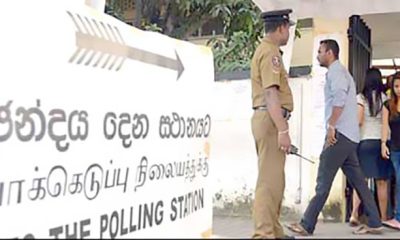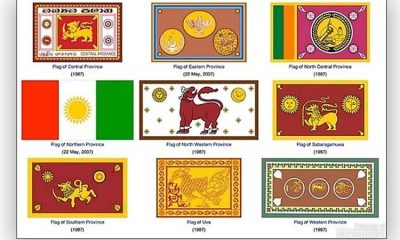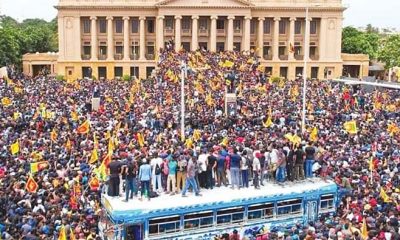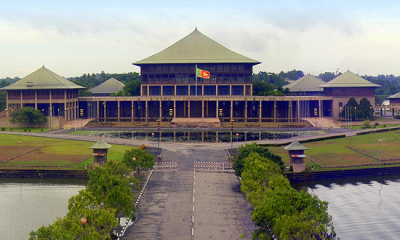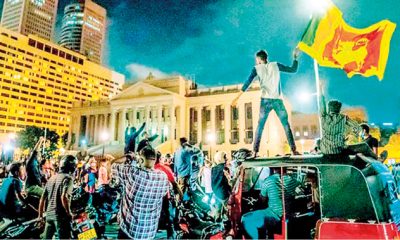Features
ABOLISHING THE EXECUTIVE PRESIDENCY
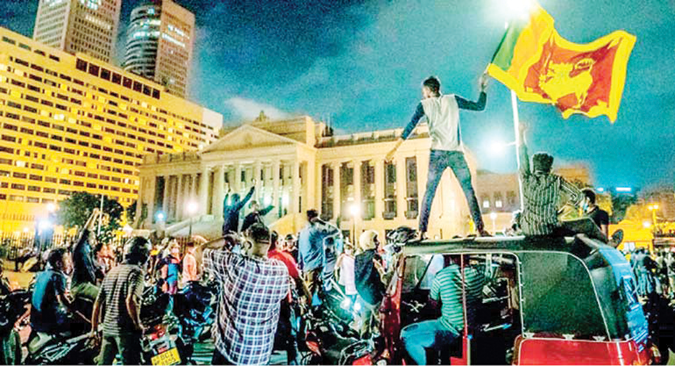
by Dr Nihal Jayawickrama
The message of the 2022 “Aragalaya”, which drove a President and a Prime Minister and other members of that political family out of office, expressed in clear and explicit terms, was a complete rejection of the authoritarian, patronage-based, corrupt system of governance introduced into this country by the 1978 Constitution and its 21 Amendments. A total of 45 years of autocratic presidential rule marked by massive loss of human life and unprecedented levels of corruption, have demonstrated the need to restore the system of government that this country enjoyed for 25, if not 30, years since 1947.
The Parliamentary Executive System
I am old enough to have lived through all three post-Independence Constitutions of this country, and especially the first. In my view, the 1946 Constitution served the country and its peoples best. If the purpose of a national constitution is to establish the essential framework of government by creating the principal institutions and defining their powers, that was precisely what it did. Drafted by one trained legal draftsman, based on the report of the Soulbury Commission and related documents, and endorsed by the four major communities represented in the State Council, that Constitution served us for 25 years without any significant amendments. Expressed in only 92 sections, it was, in my opinion, the model constitution. If it failed in some respects, it was due to the absence of a Bill of Rights.
Under that parliamentary executive system of government, the Head of State, who was also Head of the Executive, and Commander-in-Chief of the Armed Forces, acted on the advice of the Prime Minister, while the Cabinet of Ministers headed by the Prime Minister and drawn from Parliament was charged with the direction and control of the Government and was collectively responsible to Parliament. That system facilitated regular democratic elections and periodic changes of government which enabled both right-wing and centrist or left-of-centre political parties to implement their respective economic and social policies without any hindrance.
The parliamentary executive system of governance it provided was flexible enough to deal effectively and expeditiously with the sudden death of the Prime Minister in 1951, an island-wide Hartal in 1953, the assassination of the Prime Minister in 1959, the attempted military Coup d’état in 1962, and the bloody JVP Insurgency in 1971. The independence of the Judiciary was protected, and so was that of the Public Service. As a Permanent Secretary under that Constitution during the first two years of my seven-year term, I had the freedom to supervise the departments assigned to the Ministry, subject only to policy directions from my Minister. On one occasion when I refused to comply with a specific non-policy direction, I was reported to the Prime Minister who, fortunately, had a clearer understanding of constitutional principles.
The Constitutional Head of State
For 30 years, the constitutional Head of State was the principal unifying figure in the country; the non-partisan, independent, symbol of the State. Opposition parties could approach the President in the knowledge that he was a neutral figure. When, in 1972, a conflict developed between the Constitutional Court and the National State Assembly, and the Judges refused to speak to the Speaker or the Ministers, it was at President’s House that each party sat on either side of the conference table, with the President at the head, to commence a dialogue to try to resolve their differences.
That exercise, however, failed. When, in 1976, following a long period of “cold war” between the Supreme Court and the Ministry of Justice, the Minister decided it was time to break the ice, and invited the Chief Justice and other Judges of the Supreme Court to the Ministry to tea, it was to President’s House that they proceeded instead, to complain of the invitation, which they perceived to be an interference with the judiciary. Mr William Gopallawa was not a mere ceremonial president; he was not a mere cipher. I was summoned by him on several occasions when he disagreed or felt uncomfortable with advice tendered to him, either by a Minister or the Prime Minister. He did not hesitate to invite the Prime Minister, or the Minister concerned, to reconsider the advice.
The Presidential Executive System
That parliamentary executive system of government was replaced in 1978 by a presidential executive system of government, not because the former, which prevails to this day in democratic countries from Canada and the United Kingdom, through India, Singapore, and Malaysia, to Australia and New Zealand, had somehow failed the people of Sri Lanka. It was replaced not because the people of Sri Lanka cried out aloud nostalgically for a return to some form of monarchical rule.
It was replaced because that was the wish and desire of one senior political leader who probably sincerely believed that that was the best form of government for our country. However, from 1966, during the next seven years, Mr. J.R. Jayewardene failed to convince his party leader, Mr. Dudley Senanayake, of his strong belief that an Executive President chosen directly by the people, seated in power for a fixed number of years, and not subject to the whims and fancies of an elected legislature, was what the country required.
He also proposed an electoral system where there were no electorates; where each political party presented a list of candidates; where the voter voted for the party; and the legislators were chosen from that list, the number depending on the votes cast for each party. He predicted that that system would enable the best equipped men and women in the country to take part in our political life. Little did he know that 50 years later the “best equipped men and women” would include 90 parliamentarians who had not even attempted to sit the GCE “O” Levels. Prime Minister Dudley Senanayake did not support this proposal; nor did the UNP Working Committee.
At the general election of July 1977, when he led his party to an unprecedented five-sixth majority in the National State Assembly (NSA), Prime Minister Jayewardena was able to fulfil his dream project. In October of that year, a Bill to amend the Constitution, certified by his Cabinet as being “urgent in the national interest”, which sought to transfer all the executive powers of the Prime Minister to the President, and for the incumbent Prime Minister to be deemed the first nationally elected President, was passed by the NSA. On February 4, 1978, that constitutional amendment was brought into force, and Mr. Jayewardene was sworn-in on Galle Face Green as the first Executive President of Sri Lanka.
Meanwhile, a Select Committee of the NSA was established to consider the revision of the 1972 Constitution. At the concluding stages of that Committee, the Government tabled a wholly new draft constitution, the author of which was not disclosed. On August 31, 1978, with the TULF and the SLFP walking out, and with none voting against, the NSA enacted the Constitution of the Democratic Socialist Republic of Sri Lanka. On September 8, 1978, the new Constitution was brought into operation, and the 168 members of the NSA were deemed to have been elected as Members of the new Parliament that was established.
Parliamentary Majority Essential
The 1978 Constitution, under which the President was the source of all power and patronage and was beyond the reach of the law and the judiciary, was a Constitution of Mr Jayewardene, by Mr. Jayewardene, for Mr Jayewardene. Dr Colvin R. de Silva’s prescient plea that he should not bequeath it to his successors, was ignored. The success of his project, however, was entirely dependent on one essential factor – that the President elected by the people was supported by a clear majority in the Parliament elected by the people.
I attended a few meetings of the select committee as an adviser to Mrs Bandaranaike and Mr Maithripala Senanayake, since neither of them was a lawyer. At one of the meetings, I had occasion to ask Mr Jayewardene what the position would be if a political party opposed to the President secured a majority in Parliament. He thought that would be unlikely during his term of office, but if that were to happen, he said he would take a step back and be a constitutional Head of State. He, of course, ensured that that did not happen during his presidency by securing an extension of the life of Parliament for a further six-year term through an amendment of the Constitution, a rigged referendum, and through many other devices such as obtaining undated letters of resignation, maintaining secret files on the financial and other activities of his Ministers, and by imposing civic disabilities on his political opponents.
His successors, however, were either not so fortunate, or did not possess his political acumen. In August 1994, UNP President Wijetunge, faced with a Parliament in which the United Front had a majority, chose to take a step back to spend the last three months of his term as a constitutional Head of State. In 2001, President Kumaratunge, faced with a Parliament controlled by the UNP, chose “cohabitation” for a while, and then used her presidential powers to dissolve Parliament prematurely, having previously assured the Speaker that she would never do that while a political party other than her own commanded a working majority. In the next 10 years, both she and President Rajapaksa regularly lured Members of the Opposition to secure the majority which they required, using methods that should have alerted any self-respecting Bribery Commissioner and kept him awake at night.
One does not need to be reminded of the shambolic relationship that prevailed between the President and the Prime Minister in the “Yahapalana” government; nor of the inconceivable situation today where the President is compelled to function with a Cabinet of Ministers and a parliamentary majority politically opposed to him.
A Political Consensus Exists
For over 30 years, every major political party has pledged to restore the parliamentary executive form of government. For that purpose, every major political party has supported the election of the President by Parliament (or other representative body).
In 2000, President Chandrika Kumaratunge, as head of the SLFP government presented a draft Constitution which provided for the President and two Vice-Presidents (the latter drawn from ethnic communities different to that of the President) to be elected by Parliament.
In 2013, the Ranil Wickremesinghe-led UNP published the text of the principles upon which a new Constitution would be formulated after it forms a government. Among them was that the Executive Presidency would be abolished.
In 2015, President Sirisena stood before the casket bearing the remains of the late Rev. Maduluwawe Sobitha and, with his head bowed, swore an oath that he would ensure that all remnants of executive power would be removed from the office of the President of the Republic.
In 2018, a panel of experts appointed by the UNP/SLFP Yahapalana Government led by President Sirisena and Prime Minister Ranil Wickremesinghe prepared and published a draft Constitution which required the President to be elected by Parliament and to exercise many of his/her powers on advice.
In 2018, the JVP headed by Anura Kumara Dissanayake, presented a Bill to amend the Constitution to enable the non-executive President to be elected by Parliament.
In 2021, the SJB led by Sajith Premadasa proposed an amendment to the Constitution to enable a non-executive President to be elected by Parliament.
A Referendum Is Not Required
The 1978 constitution introduced for the first time into the Sri Lankan constitutional process the concept of a referendum. In the tradition of the Greek city states, actual decision-making was being restored to the people. The articles of the constitution which Parliament may not amend without approval at a referendum are regarded as the fundamental elements of the State and are explicitly set out in Article 83. They are: its name (art. 1), its unitary character (art.2), the inalienability of the people’s sovereignty (art.3), its national flag (art.6), its national anthem (art.7), its national day (art.8), the foremost place accorded to Buddhism (art.9), the freedom of thought, conscience and religion (art.10), the prohibition of torture (art.11), any extension of the term of office of the President (art.30), and any extension of the life of Parliament (art.62).
The introduction of a referendum appears to have been intended as a means of ensuring that these fundamental elements would ordinarily remain unaltered. In that regard, the Constitution has distinguished the principle from its implementation. For example, while the life of Parliament or the term of office of the President cannot be extended without approval at a referendum, any reduction of the life or term can be achieved by an amendment passed in Parliament. Similarly, while the concept of the people’s sovereignty is unalterable (thus preventing its alienation to a monarch, a military officer or to a particular community), the manner of its exercise is left to be determined by Parliament. Thus, a requirement that the executive power of the people be exercised by the President on the advice of the Prime Minister is an amendment capable of being made by Parliament by a two-thirds majority without reference to a referendum, as was held by the Supreme Court in 2015.
Unfortunately, the decision of the Bench of three Judges of the Supreme Court (Chief Justice Sripavan and Justices Ekanayake and Dep) on the 19th Amendment which enabled Parliament to amend the Constitution to require the President to act on the advice of the Prime Minister in respect of several matters, has not been followed in subsequent determinations. For example, the proposal made in 2019 by the JVP that the impending election to the office of the then non-executive Presidency be by a majority vote in Parliament was rejected by the Supreme Court. Justice De Abrew held that that would violate Article 4, and that any amendment of Article 4 requires approval by the people at a referendum. Article 4 is not an entrenched provision specified in Article 83. He also ignored the fact that Article 40 of the Constitution already provided for Parliament to elect the President in certain circumstances.
Replacement of List-System with Constituencies
The election of members of parliament from 25 District lists, based on proportional representation, was introduced by Mr. J.R. Jayewardene as an integral element in the presidential executive system of governance. Since each District encompassed several former constituencies, the expenditure involved in campaigning in such a large extent of territory, and the need to raise money for that purpose from various sources, inevitably on a quid pro quo basis, has been identified as one of the principal factors leading to corruption. The return to the single-member/multi-member constituencies, combined with a system of proportional representation to ensure that unrepresented interests are adequately represented, ought to be an essential adjunct to a parliamentary executive system of governance.
Features
The heart-friendly health minister

by Dr Gotabhya Ranasinghe
Senior Consultant Cardiologist
National Hospital Sri Lanka
When we sought a meeting with Hon Dr. Ramesh Pathirana, Minister of Health, he graciously cleared his busy schedule to accommodate us. Renowned for his attentive listening and deep understanding, Minister Pathirana is dedicated to advancing the health sector. His openness and transparency exemplify the qualities of an exemplary politician and minister.
Dr. Palitha Mahipala, the current Health Secretary, demonstrates both commendable enthusiasm and unwavering support. This combination of attributes makes him a highly compatible colleague for the esteemed Minister of Health.
Our discussion centered on a project that has been in the works for the past 30 years, one that no other minister had managed to advance.
Minister Pathirana, however, recognized the project’s significance and its potential to revolutionize care for heart patients.
The project involves the construction of a state-of-the-art facility at the premises of the National Hospital Colombo. The project’s location within the premises of the National Hospital underscores its importance and relevance to the healthcare infrastructure of the nation.
This facility will include a cardiology building and a tertiary care center, equipped with the latest technology to handle and treat all types of heart-related conditions and surgeries.
Securing funding was a major milestone for this initiative. Minister Pathirana successfully obtained approval for a $40 billion loan from the Asian Development Bank. With the funding in place, the foundation stone is scheduled to be laid in September this year, and construction will begin in January 2025.
This project guarantees a consistent and uninterrupted supply of stents and related medications for heart patients. As a result, patients will have timely access to essential medical supplies during their treatment and recovery. By securing these critical resources, the project aims to enhance patient outcomes, minimize treatment delays, and maintain the highest standards of cardiac care.
Upon its fruition, this monumental building will serve as a beacon of hope and healing, symbolizing the unwavering dedication to improving patient outcomes and fostering a healthier society.We anticipate a future marked by significant progress and positive outcomes in Sri Lanka’s cardiovascular treatment landscape within the foreseeable timeframe.
Features
A LOVING TRIBUTE TO JESUIT FR. ALOYSIUS PIERIS ON HIS 90th BIRTHDAY

by Fr. Emmanuel Fernando, OMI
Jesuit Fr. Aloysius Pieris (affectionately called Fr. Aloy) celebrated his 90th birthday on April 9, 2024 and I, as the editor of our Oblate Journal, THE MISSIONARY OBLATE had gone to press by that time. Immediately I decided to publish an article, appreciating the untiring selfless services he continues to offer for inter-Faith dialogue, the renewal of the Catholic Church, his concern for the poor and the suffering Sri Lankan masses and to me, the present writer.
It was in 1988, when I was appointed Director of the Oblate Scholastics at Ampitiya by the then Oblate Provincial Fr. Anselm Silva, that I came to know Fr. Aloy more closely. Knowing well his expertise in matters spiritual, theological, Indological and pastoral, and with the collaborative spirit of my companion-formators, our Oblate Scholastics were sent to Tulana, the Research and Encounter Centre, Kelaniya, of which he is the Founder-Director, for ‘exposure-programmes’ on matters spiritual, biblical, theological and pastoral. Some of these dimensions according to my view and that of my companion-formators, were not available at the National Seminary, Ampitiya.
Ever since that time, our Oblate formators/ accompaniers at the Oblate Scholasticate, Ampitiya , have continued to send our Oblate Scholastics to Tulana Centre for deepening their insights and convictions regarding matters needed to serve the people in today’s context. Fr. Aloy also had tried very enthusiastically with the Oblate team headed by Frs. Oswald Firth and Clement Waidyasekara to begin a Theologate, directed by the Religious Congregations in Sri Lanka, for the contextual formation/ accompaniment of their members. It should very well be a desired goal of the Leaders / Provincials of the Religious Congregations.
Besides being a formator/accompanier at the Oblate Scholasticate, I was entrusted also with the task of editing and publishing our Oblate journal, ‘The Missionary Oblate’. To maintain the quality of the journal I continue to depend on Fr. Aloy for his thought-provoking and stimulating articles on Biblical Spirituality, Biblical Theology and Ecclesiology. I am very grateful to him for his generous assistance. Of late, his writings on renewal of the Church, initiated by Pope St. John XX111 and continued by Pope Francis through the Synodal path, published in our Oblate journal, enable our readers to focus their attention also on the needed renewal in the Catholic Church in Sri Lanka. Fr. Aloy appreciated very much the Synodal path adopted by the Jesuit Pope Francis for the renewal of the Church, rooted very much on prayerful discernment. In my Religious and presbyteral life, Fr.Aloy continues to be my spiritual animator / guide and ongoing formator / acccompanier.
Fr. Aloysius Pieris, BA Hons (Lond), LPh (SHC, India), STL (PFT, Naples), PhD (SLU/VC), ThD (Tilburg), D.Ltt (KU), has been one of the eminent Asian theologians well recognized internationally and one who has lectured and held visiting chairs in many universities both in the West and in the East. Many members of Religious Congregations from Asian countries have benefited from his lectures and guidance in the East Asian Pastoral Institute (EAPI) in Manila, Philippines. He had been a Theologian consulted by the Federation of Asian Bishops’ Conferences for many years. During his professorship at the Gregorian University in Rome, he was called to be a member of a special group of advisers on other religions consulted by Pope Paul VI.
Fr. Aloy is the author of more than 30 books and well over 500 Research Papers. Some of his books and articles have been translated and published in several countries. Among those books, one can find the following: 1) The Genesis of an Asian Theology of Liberation (An Autobiographical Excursus on the Art of Theologising in Asia, 2) An Asian Theology of Liberation, 3) Providential Timeliness of Vatican 11 (a long-overdue halt to a scandalous millennium, 4) Give Vatican 11 a chance, 5) Leadership in the Church, 6) Relishing our faith in working for justice (Themes for study and discussion), 7) A Message meant mainly, not exclusively for Jesuits (Background information necessary for helping Francis renew the Church), 8) Lent in Lanka (Reflections and Resolutions, 9) Love meets wisdom (A Christian Experience of Buddhism, 10) Fire and Water 11) God’s Reign for God’s poor, 12) Our Unhiddden Agenda (How we Jesuits work, pray and form our men). He is also the Editor of two journals, Vagdevi, Journal of Religious Reflection and Dialogue, New Series.
Fr. Aloy has a BA in Pali and Sanskrit from the University of London and a Ph.D in Buddhist Philosophy from the University of Sri Lankan, Vidyodaya Campus. On Nov. 23, 2019, he was awarded the prestigious honorary Doctorate of Literature (D.Litt) by the Chancellor of the University of Kelaniya, the Most Venerable Welamitiyawe Dharmakirthi Sri Kusala Dhamma Thera.
Fr. Aloy continues to be a promoter of Gospel values and virtues. Justice as a constitutive dimension of love and social concern for the downtrodden masses are very much noted in his life and work. He had very much appreciated the commitment of the late Fr. Joseph (Joe) Fernando, the National Director of the Social and Economic Centre (SEDEC) for the poor.
In Sri Lanka, a few religious Congregations – the Good Shepherd Sisters, the Christian Brothers, the Marist Brothers and the Oblates – have invited him to animate their members especially during their Provincial Congresses, Chapters and International Conferences. The mainline Christian Churches also have sought his advice and followed his seminars. I, for one, regret very much, that the Sri Lankan authorities of the Catholic Church –today’s Hierarchy—- have not sought Fr.
Aloy’s expertise for the renewal of the Catholic Church in Sri Lanka and thus have not benefited from the immense store of wisdom and insight that he can offer to our local Church while the Sri Lankan bishops who governed the Catholic church in the immediate aftermath of the Second Vatican Council (Edmund Fernando OMI, Anthony de Saram, Leo Nanayakkara OSB, Frank Marcus Fernando, Paul Perera,) visited him and consulted him on many matters. Among the Tamil Bishops, Bishop Rayappu Joseph was keeping close contact with him and Bishop J. Deogupillai hosted him and his team visiting him after the horrible Black July massacre of Tamils.
Features
A fairy tale, success or debacle

Sri Lanka-Singapore Free Trade Agreement
By Gomi Senadhira
senadhiragomi@gmail.com
“You might tell fairy tales, but the progress of a country cannot be achieved through such narratives. A country cannot be developed by making false promises. The country moved backward because of the electoral promises made by political parties throughout time. We have witnessed that the ultimate result of this is the country becoming bankrupt. Unfortunately, many segments of the population have not come to realize this yet.” – President Ranil Wickremesinghe, 2024 Budget speech
Any Sri Lankan would agree with the above words of President Wickremesinghe on the false promises our politicians and officials make and the fairy tales they narrate which bankrupted this country. So, to understand this, let’s look at one such fairy tale with lots of false promises; Ranil Wickremesinghe’s greatest achievement in the area of international trade and investment promotion during the Yahapalana period, Sri Lanka-Singapore Free Trade Agreement (SLSFTA).
It is appropriate and timely to do it now as Finance Minister Wickremesinghe has just presented to parliament a bill on the National Policy on Economic Transformation which includes the establishment of an Office for International Trade and the Sri Lanka Institute of Economics and International Trade.
Was SLSFTA a “Cleverly negotiated Free Trade Agreement” as stated by the (former) Minister of Development Strategies and International Trade Malik Samarawickrama during the Parliamentary Debate on the SLSFTA in July 2018, or a colossal blunder covered up with lies, false promises, and fairy tales? After SLSFTA was signed there were a number of fairy tales published on this agreement by the Ministry of Development Strategies and International, Institute of Policy Studies, and others.
However, for this article, I would like to limit my comments to the speech by Minister Samarawickrama during the Parliamentary Debate, and the two most important areas in the agreement which were covered up with lies, fairy tales, and false promises, namely: revenue loss for Sri Lanka and Investment from Singapore. On the other important area, “Waste products dumping” I do not want to comment here as I have written extensively on the issue.
1. The revenue loss
During the Parliamentary Debate in July 2018, Minister Samarawickrama stated “…. let me reiterate that this FTA with Singapore has been very cleverly negotiated by us…. The liberalisation programme under this FTA has been carefully designed to have the least impact on domestic industry and revenue collection. We have included all revenue sensitive items in the negative list of items which will not be subject to removal of tariff. Therefore, 97.8% revenue from Customs duty is protected. Our tariff liberalisation will take place over a period of 12-15 years! In fact, the revenue earned through tariffs on goods imported from Singapore last year was Rs. 35 billion.
The revenue loss for over the next 15 years due to the FTA is only Rs. 733 million– which when annualised, on average, is just Rs. 51 million. That is just 0.14% per year! So anyone who claims the Singapore FTA causes revenue loss to the Government cannot do basic arithmetic! Mr. Speaker, in conclusion, I call on my fellow members of this House – don’t mislead the public with baseless criticism that is not grounded in facts. Don’t look at petty politics and use these issues for your own political survival.”
I was surprised to read the minister’s speech because an article published in January 2018 in “The Straits Times“, based on information released by the Singaporean Negotiators stated, “…. With the FTA, tariff savings for Singapore exports are estimated to hit $10 million annually“.
As the annual tariff savings (that is the revenue loss for Sri Lanka) calculated by the Singaporean Negotiators, Singaporean $ 10 million (Sri Lankan rupees 1,200 million in 2018) was way above the rupees’ 733 million revenue loss for 15 years estimated by the Sri Lankan negotiators, it was clear to any observer that one of the parties to the agreement had not done the basic arithmetic!
Six years later, according to a report published by “The Morning” newspaper, speaking at the Committee on Public Finance (COPF) on 7th May 2024, Mr Samarawickrama’s chief trade negotiator K.J. Weerasinghehad had admitted “…. that forecasted revenue loss for the Government of Sri Lanka through the Singapore FTA is Rs. 450 million in 2023 and Rs. 1.3 billion in 2024.”
If these numbers are correct, as tariff liberalisation under the SLSFTA has just started, we will pass Rs 2 billion very soon. Then, the question is how Sri Lanka’s trade negotiators made such a colossal blunder. Didn’t they do their basic arithmetic? If they didn’t know how to do basic arithmetic they should have at least done their basic readings. For example, the headline of the article published in The Straits Times in January 2018 was “Singapore, Sri Lanka sign FTA, annual savings of $10m expected”.
Anyway, as Sri Lanka’s chief negotiator reiterated at the COPF meeting that “…. since 99% of the tariffs in Singapore have zero rates of duty, Sri Lanka has agreed on 80% tariff liberalisation over a period of 15 years while expecting Singapore investments to address the imbalance in trade,” let’s turn towards investment.
Investment from Singapore
In July 2018, speaking during the Parliamentary Debate on the FTA this is what Minister Malik Samarawickrama stated on investment from Singapore, “Already, thanks to this FTA, in just the past two-and-a-half months since the agreement came into effect we have received a proposal from Singapore for investment amounting to $ 14.8 billion in an oil refinery for export of petroleum products. In addition, we have proposals for a steel manufacturing plant for exports ($ 1 billion investment), flour milling plant ($ 50 million), sugar refinery ($ 200 million). This adds up to more than $ 16.05 billion in the pipeline on these projects alone.
And all of these projects will create thousands of more jobs for our people. In principle approval has already been granted by the BOI and the investors are awaiting the release of land the environmental approvals to commence the project.
I request the Opposition and those with vested interests to change their narrow-minded thinking and join us to develop our country. We must always look at what is best for the whole community, not just the few who may oppose. We owe it to our people to courageously take decisions that will change their lives for the better.”
According to the media report I quoted earlier, speaking at the Committee on Public Finance (COPF) Chief Negotiator Weerasinghe has admitted that Sri Lanka was not happy with overall Singapore investments that have come in the past few years in return for the trade liberalisation under the Singapore-Sri Lanka Free Trade Agreement. He has added that between 2021 and 2023 the total investment from Singapore had been around $162 million!
What happened to those projects worth $16 billion negotiated, thanks to the SLSFTA, in just the two-and-a-half months after the agreement came into effect and approved by the BOI? I do not know about the steel manufacturing plant for exports ($ 1 billion investment), flour milling plant ($ 50 million) and sugar refinery ($ 200 million).
However, story of the multibillion-dollar investment in the Petroleum Refinery unfolded in a manner that would qualify it as the best fairy tale with false promises presented by our politicians and the officials, prior to 2019 elections.
Though many Sri Lankans got to know, through the media which repeatedly highlighted a plethora of issues surrounding the project and the questionable credentials of the Singaporean investor, the construction work on the Mirrijiwela Oil Refinery along with the cement factory began on the24th of March 2019 with a bang and Minister Ranil Wickremesinghe and his ministers along with the foreign and local dignitaries laid the foundation stones.
That was few months before the 2019 Presidential elections. Inaugurating the construction work Prime Minister Ranil Wickremesinghe said the projects will create thousands of job opportunities in the area and surrounding districts.
The oil refinery, which was to be built over 200 acres of land, with the capacity to refine 200,000 barrels of crude oil per day, was to generate US$7 billion of exports and create 1,500 direct and 3,000 indirect jobs. The construction of the refinery was to be completed in 44 months. Four years later, in August 2023 the Cabinet of Ministers approved the proposal presented by President Ranil Wickremesinghe to cancel the agreement with the investors of the refinery as the project has not been implemented! Can they explain to the country how much money was wasted to produce that fairy tale?
It is obvious that the President, ministers, and officials had made huge blunders and had deliberately misled the public and the parliament on the revenue loss and potential investment from SLSFTA with fairy tales and false promises.
As the president himself said, a country cannot be developed by making false promises or with fairy tales and these false promises and fairy tales had bankrupted the country. “Unfortunately, many segments of the population have not come to realize this yet”.
(The writer, a specialist and an activist on trade and development issues . )


